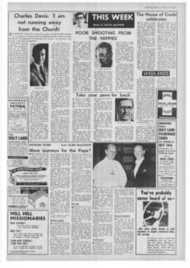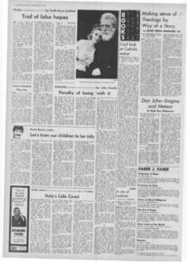Page 4, 28th July 1967
Page 4

Report an error
Noticed an error on this page?If you've noticed an error in this article please click here to report it.
Tags
Share
Related articles
'dream' Grows In 75 Lands
Mgr. Cardijn Started It. The Popes Blessed It. Father...
In To Few Words By Jotter
Britishers In High
The 'first' Story Of Mgr. Cardijn
Cardinal Cardijn's message to young workers
by PATRICK KEEGAN
THE EVENING of Fri' day, February 19., 1965, was a very happy one for all of us. We were at the small Convent of the Sacred Heart on the Via Ulysse Seni in Rome, run by a wonderful community of nuns. Mgr. Cardijn was smoking a huge cigar and his secretary Marguerite Fievez was showing me a pile of robes he would have to wear, first as an Archbishop and then as a Cardinal.
We teased him about looking like Robin Redbreast. He got a bit anxious about walking with the crozier so he practised for about five minutes still holding on to his cigar.
In reply to the remarks he would chuckle and say "How is it possible." This was his favourite English phrase and I had heard him use it through the years as an all round standby, It could be a question, or a non-committal remark used while he was thinking things over.
He was, above all, a man of reflection, constantly searching. He would take a lot of time to mull over ideas. Most people thought of him as the great inspirer and speaker at large meetings which he certainly was: nevertheless, he would prepare such a meeting by drafting points and underscoring in red the main points.
He read enormously. Sometimes he would surprise me by landing me with a number of En g l i s h reviews heavily marked throughout with the question "What do you think?" He was an ordered man and demanded the same from the people he worked with, It is just too simple to think of him as the man with the single idea, He certainly had a central idea — the Church as a l i v in g community, looking with joy and hope to the modern industrial world of today and of the future, All his meditations that he usually gave before committee meetings centred on a hope based on the Resurrection. There was no marked nostalgia for the past, but always urgency for the need to baptize the modern industrial world.
Canon Arbuthnott summed this up very well in the book' he wrote on the life of the Cardinal, "Cardijn seized the two terminals, God and man, to cry 'Contact'. the result might be explosive but so it is meant to be , "
During the Council many Bishops and pereti constantly commented on the great prophetic vision of the Church and its role in the modern world that Cardijn possessed. Others mentioned that his thoughts and ideas had been a preparation for the Vatican Council.
I personally believe that his vision grew out of the fact that he really possessed a great priestly love for young workers. This was the grace of his priesthood — one could go so far as to say it was a form of midwifery bringing forth the people of God, especially the young workers.
Possibly many priests would not be as troubled as they are at the present time if they had studied this aspect 'of the Cardinal and tried to do likewise. He saw, as a normal per
manent part of his priestly life, the task to call, sustain and encourage young workers to discover the supernatural significance of the simple facts of their human daily life: relating the insight of grace to the real needs of ordinary folk.
On our travels many priests would ask him what was the secret of it all. He would shrug his shoulders and say "You will never learn unless you begin. I started with five young workers. You start and restart all your priestly life."
This conception of the right partnership between priests and lay people surely is the key to the future wellbeing of a postconciliar Church. In this I think the Cardinal was a great teacher and example.
His obstinate belief in the apostolic potentiality of the simplest young worker. dominates all this thought. The young workers were his part of the people of God, for whom he felt a special priestly responsibility. Yet it is true that all that he said of the young worker could equally apply to all the people of God.
"Young workers you have a divine vocation, an irreplaceable mission from the Church, you arc called to be sons of God, not just when you are dead, but here and now in all aspects of your daily life. Anything in your situation of work, neighbourhood, leisure or home that hinders you from realising this truth, must be changed. In this transformation you are the primary and indispensable element, No one can replace you . "
A simple original Christian truth of faith that could remain just words in a book, or become a dynamic truth to live by. All his life he repeated this truth. Repeated the obvious. but with a deep meaning, a conviction and a prophetic dynamism.
As a result hundreds of thousands of working people throughout the world discovered that they also are the Church; that the Church is not just bricks and mortar on a hill.
*.laveph Cardijn, Dar ton, Longman and Todd. "Where We Stand" series.
blog comments powered by Disqus









